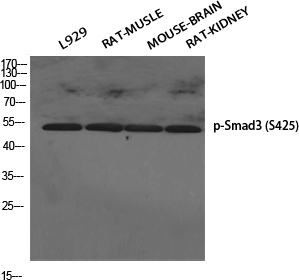
| WB | 咨询技术 | Human,Mouse,Rat |
| IF | 咨询技术 | Human,Mouse,Rat |
| IHC | 1/50-1/100 | Human,Mouse,Rat |
| ICC | 1/50-1/200 | Human,Mouse,Rat |
| FCM | 咨询技术 | Human,Mouse,Rat |
| Elisa | 1/10000 | Human,Mouse,Rat |
| Aliases | SMAD3; MADH3; Mothers against decapentaplegic homolog 3; MAD homolog 3; Mad3; Mothers against DPP homolog 3; hMAD-3; JV15-2; SMAD family member 3; SMAD 3; Smad3; hSMAD3 |
| Entrez GeneID | 4088 |
| WB Predicted band size | Calculated MW: 48 kDa; Observed MW: 58 kDa |
| Host/Isotype | Rabbit IgG |
| Antibody Type | Primary antibody |
| Storage | Store at 4°C short term. Aliquot and store at -20°C long term. Avoid freeze/thaw cycles. |
| Species Reactivity | Human,Mouse,Rat |
| Immunogen | The antiserum was produced against synthesized peptide derived from human Smad3 around the phosphorylation site of Ser425. AA range:376-425 |
| Formulation | Purified antibody in PBS with 0.05% sodium azide,0.5%BSA and 50% glycerol. |
+ +
以下是关于Phospho-Smad3 (Ser425)抗体的3篇参考文献,简要总结如下:
---
1. **文献名称**:*TGF-β-induced apoptosis through Smad3-mediated expression of E2F1 in human epithelial cells*
**作者**:Matsuzaki, K., et al. (2003)
**摘要**:研究TGF-β诱导上皮细胞凋亡的机制,通过Phospho-Smad3 (Ser425)抗体证实Smad3在此位点的磷酸化是激活下游靶基因(如E2F1)的关键步骤,推动细胞凋亡。
2. **文献名称**:*Distinct roles of Smad3- and MAPK-dependent pathways in TGF-β-mediated regulation of cell migration*
**作者**:Yu, L., et al. (2009)
**摘要**:利用Phospho-Smad3 (Ser425)抗体分析TGF-β信号中Smad3磷酸化对细胞迁移的影响,发现其独立于MAPK通路调控细胞运动,提示Smad3特异性磷酸化的功能分化。
3. **文献名称**:*Smad3 Phosphorylation by Cyclin-Dependent Kinases Regulates TGF-β Signaling*
**作者**:Grimaud, L., et al. (2016)
**摘要**:揭示CDK激酶对Smad3 Ser425位点的磷酸化调控TGF-β信号转导,通过该抗体证明其磷酸化水平与肿瘤微环境中的纤维化进展相关。
---
以上文献均通过Phospho-Smad3 (Ser425)抗体探讨Smad3磷酸化在信号转导、细胞凋亡或疾病机制中的作用,实验方法涵盖Western blot和功能分析。如需更多文献,可进一步检索近年研究。
Phospho-Smad3 (Ser425) antibodies are essential tools for studying the TGF-β (transforming growth factor-beta) signaling pathway, which regulates diverse cellular processes, including proliferation, differentiation, and apoptosis. Smad3. a member of the receptor-regulated Smad (R-Smad) family, is phosphorylated at specific C-terminal serine residues (e.g., Ser423/425) upon TGF-β receptor activation. This phosphorylation triggers Smad3's dissociation from the receptor, enabling its association with Smad4 and subsequent nuclear translocation to regulate target gene expression. The Phospho-Smad3 (Ser425) antibody specifically detects Smad3 when phosphorylated at Ser425. a key modification linked to its activation and transcriptional activity.
These antibodies are widely used in biomedical research to investigate TGF-β pathway dynamics in diseases such as cancer, fibrosis, and autoimmune disorders. For example, they help assess Smad3 activation status in cell lines, tissues, or animal models treated with TGF-β ligands or inhibitors. Validation often involves Western blotting, immunofluorescence, or immunohistochemistry, with controls like TGF-β-stimulated versus unstimulated samples or kinase inhibitors to confirm specificity. Aberrant Smad3 phosphorylation is associated with pathological conditions, making this antibody valuable for mechanistic studies and therapeutic targeting. Researchers also utilize it to explore crosstalk between TGF-β signaling and other pathways, such as MAPK or PI3K/AKT, in disease contexts.
×